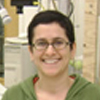Fellows
 Nicole Abaid
Nicole Abaid
Ph.D. (3rd. year), Mechanical Engineering
Year in graduate program: 6th. year (August 2005)
Research Topic:Marine systems and underwater robotics
Partner School:PS 256
Benjamin Banneker Elementary
Partner Teacher: Michael Smith
Email Nicole
Research
Under the guidance of Professor Maurizio Porfiri, Nicole is developing novel research directions in marine systems, including aquatic animals and underwater vehicles. Specifically, she is conducting theoretical and experimental research on the schooling behavior of giant danios. In a significant departure from the existing literature, where quantitative models of fish collective response are generally behavior-based, Nicole's modeling effort exploits a graph theoretic perspective wherein individual fish are represented as vertices on a graph and fish-to-fish interaction are represented as weighted or directed edges connecting vertices. The newly developed modeling framework has facilitated the application of consensus protocols to analyze spatio-temporal pattern formation of fish shoals due to engineered stimuli, such as light and sound. Nicole is also engaged in the design and development of a robotic fish that uses ionic polymer metal composites (IPMCs) for propulsion. Specifically, she has collaborated with a team of graduate students in Professor Porfiri's Dynamical Systems Laboratory, to fabricate hardware for several miniature robots and develop the software for robot's remote-controlled operation. The two streams of Nicole's research, viz., live fish collective behavior and robotic fish, will be soon merged to investigate interactions among live and robotic fish to develop an improved understanding of traits such as leadership and decision making in animal groups.
Figure: Nicole Abaid with a robotic and live fish. Nicole is adjusting the robotic arm that introduces flapping fin stimulus in the annular fish tank.
Integration in The Class Room
Nicole is integrating her research in a weekly robotics elective with sixth, seventh, and eighth grade students at an all-girls middle school. Using the student-friendly mechatronics platforms, she directs hands-on projects that illustrate basic physical concepts from Newton's law of cooling to acceleration due to gravity. Nicole's marine systems research background enables her to use pertinent biological examples as illustrations to add significance to physical concepts being learned by her students. For example, the touch sensor used to measure the average speed of a falling ball can be related to physiological features of fish that allow them to sense disturbances around them. This analogy extends the knowledge of pressure to how schooling fish gain information about their environment and their neighbors.
In addition, Nicole conducts a workshop at the annual Family Math Day at the middle school. This year, she illustrated the mathematical sequences both abstractly and tangibly by defining the rules that describe a Fibonacci sequence and by programming a mobile robot to implement the same rules, thus physically describing the famous Fibonacci spiral. By facilitating the synthesis of theoretical concepts and real-world examples in the students and their parents, she hopes to impart the excitement of scientific inquiry inherent in her research.
Figure: Students at the Urban Assembly Institute measure the acceleration of a ball due to gravity.
1 - AMPS Fellow; 2 - CBRI Fellow